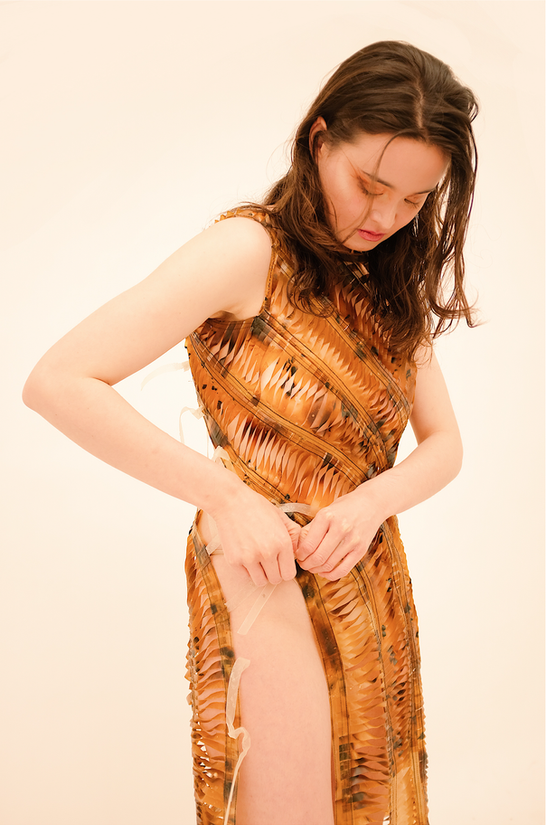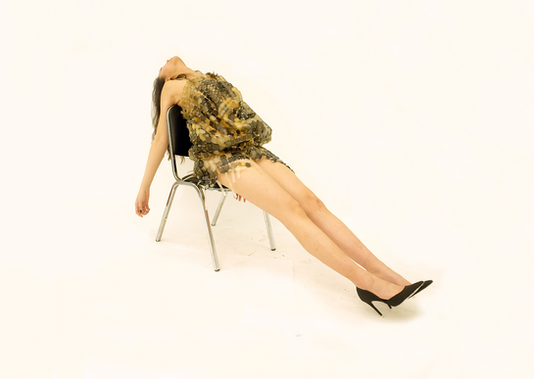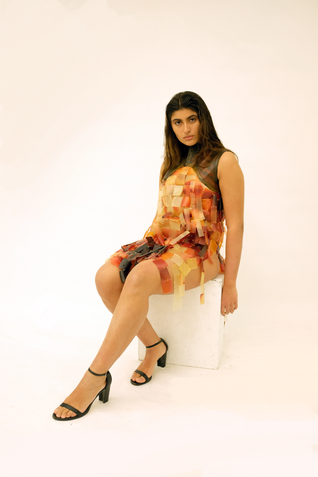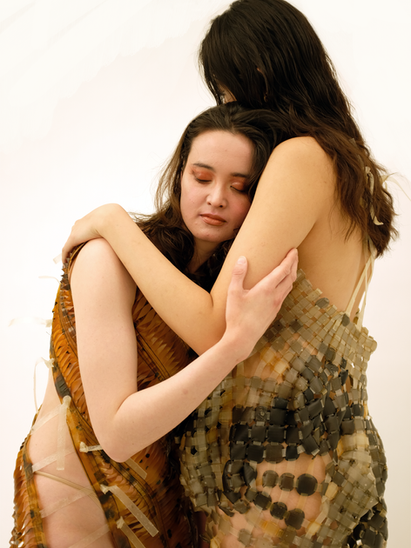INTERVIEW
Junyi Hu
Fashion Designer: Junyi Hu @madeby.jy
Photographer: Tiff Cheung @preservedsunset
Model: Emilia Mann @emilia_mann
Model: Yasemin Kirac @yasemin.kirac
Model: Susan Sima @suesuesima
A Dress Triptych made entirely out of bioplastic - a biodegradable starch-based material that reacts to heat and water. The concept and silhouette of the dresses were inspired by Zen Philosophy and its pursuit of finding beauty within impermanence. While these dresses have long disintegrated, their value was found within its creative process, from when the material is set within the lab to when it returned to the ground.
Singaporean-born womenswear designer Junyi pulls no punches when it comes to interdisciplinary design. Having lived in vastly different cities and experienced various fashion cultures, Junyi draws upon her knowledge of the human experience to keep herself inspired.
The core of her creative process involves marrying different fields of interest to address questions about our existence, such as art, science, and religion. Investigative, eco-conscious, and sophisticated, Junyi’s body of work could be pointing high fashion in a brand new direction.
Junyi’s passion for fashion design began at an early age when she witnessed the use of haute couture as a form of woman empowerment. As time passed, Junyi noticed how fashion could serve as a powerful platform; a conduit to discuss a myriad of modern-day issues.
She went on to pursue the arts at the prestigious Rhode Island School of Design, where she was first exposed to the world of biomaterials and challenged herself to design clothes using unconventional textiles. As she works with various fashion brands, from luxury womenswear to experimental streetwear, Junyi keeps her love for avant-garde design alive by inspiring others to raise questions about identity, politics, and gender.
Can you tell us about your background and how you got started in fashion design?
My fashion journey was not straightforward; I was always a multi-faceted designer interested in various art forms, such as illustration, textiles, jewelry, ceramics, sculpture, etc. Fashion was a subject that allowed me to integrate everything I enjoyed into a single discipline.
As I delved deeper into my practice, I became more acutely aware of the problems fashion presented to our planet. However, I saw these problems as opportunities to solve a greater issue. The act of redefining fashion for the better, and to address the truth of our existence along the way - that is a challenge worth undertaking.
What is your design philosophy, and how does it guide your work?
I believe fashion must extend beyond pure aesthetics. Our creative process relies upon the resources from the earth. Therefore, it is our responsibility to design and produce mindfully, and to consider the impact of the ideas we wish to express. This mindset also challenges me to work around limitations for each project. In addition, I believe impactful design is born through the marriage of polarizing disciplines, which is why a great designer should maintain an open mind.
Beyond traditional art forms, we should experiment with topics outside the context of aesthetics, such as engineering, computation, politics, or faith. These topics fuel our conceptual understanding of the world and encourage us to grow our design vocabulary.
Can you describe your design aesthetic in three words?
Restrained, abstract and cerebral.
Can you describe your creative process from concept to finished product?
I always begin my creative process by sifting through my life experiences and writing short excerpts to reflect upon them. Around the time Ephemeral Skins was created, Covid-19 was at its peak, and I entered a period of deep introspection about purpose and mental health. I sought clarity within literature and found solace in the values of Zen Buddhism.
From there, I began collecting objects, images and textured fabrics that resonated with Zen philosophy, converting them into toiles, collages and mood-boards. While most designers would define their silhouette before their material, the final forms from the Ephemeral Skins collection were derived purely from chance, guided by the repetitive motion of weaving, braiding or connecting pieces of bioplastic.
This organic draping process is how I constructed my final designs, and what makes Ephemeral Skins a truly unique collection.
How do you incorporate cultural and historical references into your designs?
To broaden my worldview and share my experiences through my designs, I would visit historical museums, landmarks, art galleries, and books, engaging all my senses to inspire my designs. In the case of Ephemeral Skins, the design celebrated Zen philosophy by implementing the rules of traditional Japanese aesthetics within the construction and silhouette of the dresses.
For example, the Yugen Dress (Black & White Look) was inspired by its namesake concept (and ink) used in Japanese mountainscape paintings. The subtle transitions between the monotones symbolize the ever-evolving potential of space - a trait admired in the Buddhist tradition.
What do you consider to be your signature style, and how has it evolved over time?
Inspired by the works of Paco Rabanne and Andy Warhol, I grew very fond of units. When a singular design is expanded through rhythm or repetition, it often results in a visually powerful textile that becomes open to symbolic interpretation. Over time, I started incorporating unique materials into my work, such as starch, ink, and other natural compounds. The combination of unique textiles and fabric manipulation allowed me to achieve an illusive visual language that conveyed ideas of flow, transcendence and space.
Can you share some challenges you've faced in your career and how you overcame them?
I experienced both internal and external struggles in my career. During the peak of COVID-19, the surge in social and climate injustices made many of us reevaluate our reasons to create. This period of uncertainty was really the catalyst that sparked my interest in biodesign, ultimately helping me hone in on a niche.
Navigating the fashion industry after graduation was also incredibly daunting. I had to quickly learn how to suppress my self-consciousness to network with photographers, stylists, and publishers so that I may promote my work. The process has made me a more confident and holistic designer.
How do you stay organized and manage your time effectively in a fast-paced industry?
It takes an incredible amount of discipline to survive in the fashion world. When I was juggling my internships with my own creative business, I would always set myself a calendar and a list of goals to fulfill by the end of the week. I often steer clear from social media to reduce my exposure to distraction. I also find that setting small, consistent and realistic goals is key to keeping myself organized.
How do you handle criticism and feedback on your designs?
I regard criticism and feedback as an immensely valuable tool in my design process. Understanding the perspectives of others on my work has often opened avenues which would otherwise be unexplored. However, given the emotional connection I have with my creations as an artist, it can be difficult to separate critique of my craft from critique of oneself. My mentors have sometimes described my process as ‘messy and undefined’ for focusing on too many topics at once. I have learned to take a step back in order to assess feedback objectively and sustain a growth mindset in my ever-evolving journey to become a better designer.
How do you stay current with fashion trends and incorporate them into your designs?
Trends are a double-edged sword. It is sometimes helpful to discover inspiration from watching runway shows and reading magazine articles. However, once you understand the process and timeline of bringing a design to market, the trend is long over by the time it appears on social media. Trend-chasing runs the risk of diluting one’s design identity. Therefore, rather than using trends to influence my designs, I would instead evaluate them to discover the type of collections I am more inclined towards, as a way to hone in on my brand.
Can you discuss any technological advancements in fashion design that you're excited about?
With everything going on in the world of tech, it is hard not to get excited about what that could mean for the future of fashion. Given my interest in materiality, it brings me joy to see a contemporary wave of fabric engineers develop eco-friendly, plant-based textiles to reduce our industry’s carbon footprint. Huge luxury brands are already collaborating with research companies to design products using vegan leathers made from mushroom roots, cactus, or kombucha. 3D printing and the virtual reality boom could also eliminate the need to produce physical samples and achieve a build-to-order model, spelling massive reforms in traditional systems of manufacture. I implore all creatives to pay close attention to these developments, for they hold a trove of endless possibilities for us to create ground-breaking work.
What advice would you give to aspiring fashion designers?
For those who seek to elevate their vision, I would start by advising them to question everything. To create and not imitate, we have to first break down all our preconceived notions. We can achieve this by constantly exposing ourselves to new experiences, people, and information. While the internet may be a great starting point, social media algorithms were designed to keep us locked within an echo chamber of our worldviews. Any attempt to rely solely on those platforms would only result in creative stagnation.
What are your goals and aspirations for the future of your fashion design career?
I am excited about my future contributions to fashion as a luxury eco-conscious designer. One of my primary goals is to bridge the gap between science and the luxury fashion market. I plan to work on several initiatives that explore the different ways materiality can lend inspiration to contemporary silhouettes. With the resources and influence fashion powerhouses possess, now is the perfect moment to invite new technology into the fashion space for product collaborations. Lastly, I wish to harness my knowledge of design and manufacturing to raise awareness of what it means to be an ethical fashion consumer. Together, we can usher in a new era for fashion defined by innovation, exploration, and sustainability.




















